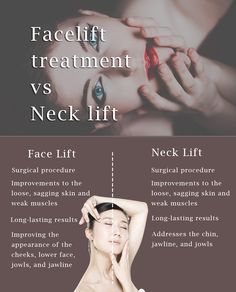Sometimes, people ask whether they would like a face lift vs neck lift. Both treatments tighten the skin to give it a smoother, younger look.
A complete facelift concentrates on most of the face and neck, whereas a neck lift focuses on the neck. Treatments such as a mini-facelift, brow lift, forehead lift, or eyelid surgery can be possible depending on your requirements.
Whichever option you pick, be sure the clinic has a board-certified plastic surgeon. Learn more about the distinctions between a facelift and a neck lift as you assess your alternatives.
What is a facelift?
The entire face and neck are visibly refreshed after a comprehensive facelift. Your surgeon repositions and drapes the extra skin after removing it. Your surgeon will remove excess fat and skin from the mid and lower face during a facelift to improve the look of the cheekbones, jawline, lips, and neck.

What can a Facelift address?
Midface drooping or sagging:
The facial tissues lose their flexibility and sink as we age. This causes the midface to seem droopy or sagging. By elevating and rearranging the deeper facial tissues, facelifts can restore the youthful shape of the cheeks.
Wrinkles and loose skin:
Facelifts are efficient at smoothing out wrinkles and tightening loose skin, especially in the lower two-thirds of the face. A facelift can produce a smoother, younger-looking appearance by removing extra skin and rearranging the underlying tissues.
Deep nasolabial folds:
These creases connect the corners of the mouth and nose. These wrinkles may deepen and look more evident over time, giving the face an aging and worn-out appearance. Lifting the skin and underlying tissues during a facelift can drastically lessen their prominence.
Jowls:
The jowls, or drooping skin around the jawline, can give the lower face a heavy, undefined appearance. This skin may be made tighter and smoother with a facelift, making the jawline seem more defined and younger.
What is a neck lift?
The same muscle laxity and collagen degradation contributing to a sagging face look also affects the neck. The platysma muscles loosen, and sagging skin below the chin forms a turkey wattle. If you have these issues, a neck lift might help.

What can a Neck lift address?
Turkey Neck:
Turkey neck is the term for the drooping, loose skin that can appear around the front of the neck and under the chin. A neck lift can efficiently tighten this skin, restoring a youthful neck shape.
Neck bands:
The platysma muscle’s separation and deterioration are to blame for the vertical bands that may appear down the front of the neck. A neck lift can tighten and restore this muscle, giving the neck a smoother, younger appearance.
Double Chin:
Excessive submental fat can give the impression of a double chin. A neck lift can eliminate excess fat, giving the neck and jawline an excellent definition.
Wrinkles and Creases:
Horizontal wrinkles and creases on the neck can be smoothed out with a neck lift, making the region look more revitalized and young.
Main differences: Face lift vs Neck lift
Although both attempt to revitalize the face and neck, the two treatments focus on various problems and locations.

The following are the main distinctions between a facelift and a neck lift:
Target areas:
A neck lift concentrates on the neck area and addresses issues including turkey neck, double chins, and neck bands. In comparison, a facelift focuses on the bottom two-thirds of the face, including the cheekbones, jawline, and nasolabial folds.
Procedure complexity:
Facelifts are typically considered more difficult than neck lifts. This is due to the complicated structure of the facial anatomy and the need for perfect surgical skills. A qualified and knowledgeable facial plastic surgeon is necessary to get the best results from any treatment.
Recovery time:
Due to the more involved surgical process in a facelift, recovery time is often more significant than a neck lift. However, the precise recuperation period will vary based on the patient and the complexity of the operation. For a facelift, patients should plan to take at least two weeks off work and regular activities. Yet, a neck lift could take one to two weeks to recover.
Scarring:
Both treatments leave some scarring. However, facelift scars are usually less visible since they are buried in the hairline and the shapes of the ears. Scars from neck lifts are often hidden behind the chin and the ears. But, they can occasionally become more noticeable, especially if the patient has shorter hair or frequently wears it up.
Assessing Your Suitability For Surgery
Your plastic surgeon will likely want to speak with you about your health, way of life, and medical background before scheduling a facelift or neck lift. Your surgeon may consider the following when determining if you are a good candidate for cosmetic surgery:
- Your surgeon will want to ensure you are healthy enough to recuperate after the surgery.
- Postpone your surgery until your weight loss or gain stabilizes.
- You have expectations for your performance that are reasonable. Every patient is different, so your expected outcome may vary.
- Your face and neck shape impact the sorts of outcomes you could experience.
Face lift vs Neck lift: Best technique to achieve your goals
It’s crucial to take into account the following aspects to choose the method that is most suited to your unique demands and objectives:
Your main worries:
Determine the parts of your face and neck that are giving you the most trouble. A facelift could be better if your main concerns are sagging skin, wrinkles, or volume loss in the lower face. A neck lift can be better if your main problems are neck-related, such as a turkey neck or double chin.
Your desired result:
Take into account the precise outcomes you anticipate from the operation. A facelift could be the best option to regain the youthful shape of your cheekbones, eliminate nasolabial folds, and define your jawline. A neck lift could be more appropriate if your objective is to enhance the look of your neck, get rid of a double chin, and smooth out neck bands.
Your age and skin condition:
Although patients of all ages can have both treatments, facelifts are often more favorable for individuals in their 40s to 60s, while neck lifts can be appropriate for those in their 30s and older. Patients with more severe aging symptoms or less elastic skin may need to combine the two treatments for the best outcomes.
Scheduling a consultation:
Consult with a board-certified face plastic surgeon to discuss your concerns and objectives. They may assist in deciding which technique is most appropriate for your particular requirements. They may also create a personalized treatment plan that is catered to your specific anatomy and the outcomes you want. The surgeon will also review possible risks, problems, and recovery expectations. It is to ensure you know the risks and are ready for the treatment.
Summary
Facelifts and neck lifts are successful treatments that improve your look by treating typical aging symptoms. Facelifts target the lower face, whereas neck lifts concentrate on the neck region.
Consider your main problems, age, skin quality, desired outcome, finances, and willingness to have surgery when choosing the best technique. Speak with a qualified and experienced facial plastic surgeon to ensure you get your desired outcomes.
You may experience a more youthful, revitalized look that increases your confidence and improves your general quality of life with the correct technique. You’ll be well-equipped to choose the best procedure to meet your needs and goals. Take your time to research carefully. Comprehend the distinctions between face lift vs neck lift. Seeking the opinion of an experienced facial plastic surgeon is highly recommended.
FAQ’s
- Can I get a neck lift without a facelift?
If you simply have a small amount of jowling (hanging skin at the jawline), undergoing a neck lift without a facelift is suitable. Continue reading about it here.
- What is the best age for a facelift?
The best age for a facelift will depend on your facial aging. Therefore, a facelift is beneficial for those in their 40s. For persons over 50, a complete facelift and neck lift are more appropriate.
- How many facelifts can I have?
Although there is no restriction on “how many facelifts you can have,” most doctors agree that 3 to 4 is the maximum.
- How Long To Wear Head Wrap After Facelift?
After a facelift, the patient is often instructed to wear a head wrap for at least a week. The headwrap should be tightened around the ears to reduce swelling and discomfort more effectively.
- I had a facelift done and have swelling under my chin. What should I do?
After a facelift, swelling under the chin is usual and can be anticipated. Everybody recovers in their way. Most patients can return to their regular activities two weeks following surgery, and most can look good with cosmetics in 14 days.









